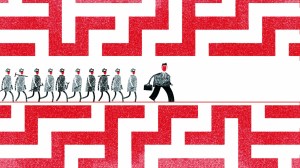Fifty years of fragmentation
The dalit movement is on the verge of being hijacked by Mayawati, Naxalites in Ambedkar’s state.

In his last days, B.R. Ambedkar wanted to wind up the Scheduled Caste Federation and form a broadbased political party that would include the poor and the oppressed across religions and castes. He had written a letter to his socialist and communist contemporaries stating his plan to float the Republican Party of India (RPI). He died on December 6, 1956 before fulfilling his dream.
His death created a vacuum, causing a leadership crisis. Dalit leaders sought to sideline his widow, Savita alias Maisaheb and son Yeshwantrao. They refused to accept the leadership of Dr Ambedkar’s trusted lieutenant Dadasaheb Gaikwad.
The RPI was formed on October 3 1957, by leaders eager to masquerade as messiahs of dalits. Within a year, the party broke into factions. The RPI leaders were from the mahar caste (to which Dr Ambedkar belonged and which converted to Buddhism en masse alongwith him in 1956). They sought to garner maximum support from the Buddhists rather than broadbasing the party. After Gaikwad’s death, most of the leaders who came into prominence allied with Congress for crumbs of power in return for the dalit votebank.
In 1972 the RPI leadership faced its toughest challenge in the form of the Dalit Panthers formed by poets, writers and activists. But the Panthers, too, ended up fragmented. Intermittently, the RPI factions have been forced to unite, but unity has proved shortlived.
These occasions included the riots and arson that followed the state’s decision to rename Marathwada University after Dr Ambedkar in 1978; and the controversy over the publication of Dr Ambedkar’s Riddles in Hinduism in 1988. The struggle for renaming the university created leaders like Ramdas Athavale. In 1990 Athavale became an ally of Sharad Pawar while Prakash Ambedkar’s politics remains unpredictable — forming alliances with Left parties or the Congress.
According to RPI leaders, the major hurdle in uniting dalits who are Buddhists with their counterparts in Hinduism has been religion. Buddhists are still bitter about the caste system, while those who remained in the Hindu fold do not identify themselves with Dr Ambedkar. Buddhists feel that they alone among the backward castes fight, but other backward castes end up enjoying the fruit. This bitterness has been politically encashed by parties like the Shiv Sena. The Sena organised Hindu-dalits against the Buddhists a few years ago.
While the RPI remained a party of Buddhists, in UP Kanshi Ram and Mayawati built up their multi-caste and multi-religious cadres — first by floating the Backward and Minority Classes Employees’ Federation (to rope in government employees recruited in the quota system); the Dalit Shoshit Samaj Sangharsh Samiti (on the lines of Panthers); and finally, the BSP which is now roping in brahmins.
Recently, when Mayawati became UP chief minister, crackers were burst in dalit localities of Maharashtra by youth disillusioned with RPI politics. The leaders do not offer answers to challenges posed by changing circumstances — as government jobs shrink and thereby the benefits of reservations. RPI leaders who dismissed BSP politics as a betrayal of the dalit cause are dumbfounded when followers point out that Mayawati can make others dance to her tune while RPI leaders have to be servile to leaders like Sharad Pawar.
The Khairlanji massacre in Bhandara district, where four members of a dalit family were killed by villagers, has exposed the RPI leadership and Naxal groups are likely to take advantage here. The incident took place on September 29, 2006, and the 50th anniversary of conversion to Buddhism by dalits was celebrated at Nagpur on October 14, 2006, but none of the dalit stalwarts even mentioned Khairlanji, apparently dictated by their friends in the Deshmukh government. It was only after some NGOs posted the information about the massacre on the internet and Leftist and Naxal groups circulated handbills in dalit localities in Nagpur that the RPI leadership swung into action.
Fifty years after the RPI’s formation, Athavale who leads the largest faction of the RPI, has called for unity of RPI factions, but his bete noire Prakash has asked him to snap ties with the NCP first. Mere RPI unity would not be enough. It’s mission impossible as even the golden jubilee celebrations are being celebrated independently by the separate factions.



- 01
- 02
- 03
- 04
- 05




























